
Termites are a group of detritophagous eusocial insects which consume a variety of decaying plant material, generally in the form of wood, leaf litter, and soil humus. They are distinguished by their moniliform antennae and the soft-bodied and often unpigmented worker caste for which they have been commonly termed "white ants"; however, they are not ants, to which they are only distantly related. About 2,972 extant species are currently described, 2,105 of which are members of the family Termitidae.
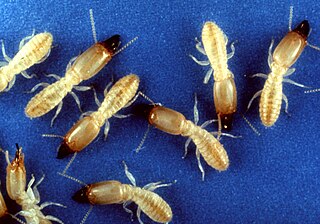
Reticulitermes flavipes, the eastern subterranean termite, is the most common termite found in North America. These termites are the most economically important wood destroying insects in the United States and are classified as pests. They feed on cellulose material such as the structural wood in buildings, wooden fixtures, paper, books, and cotton. A mature colony can range from 20,000 workers to as high as 5 million workers and the primary queen of the colony lays 5,000 to 10,000 eggs per year to add to this total.
Bacillus oleronius is a Gram-negative bacterium belonging to the genus Bacillus. However, Bacillus oleronius has Gram-positive cell wall components shared among all bacillus species. It was first described in 1995 and was found in the hindgut of the termite Reticulitermes flavipes. It is also found in the human skin parasitic mite Demodex folliculorum, and may be related to the development of a type of rosacea.

Rhinotermitidae is a family of wood-soil interface feeding termites commonly known as the Subterranean termites. Many members of this family are known pests that can cause extensive damage to buildings or other wooden structures. Most species establish colonies in wood before migrating to the ground to create diffuse nests connecting to multiple pieces of wood, with some taxa such as Coptotermitinae creating mounds or centralized carton nests within wood. All members forage via shelter tubes through the soil to sources of food. In addition, Rhinotermitidae are known for having a higher level of social complexity as compared to other termites. Communication takes place through chemical activity, more specifically through traces of cuticular hydrocarbon (CHC), or semiochemicals, acting as pheromones to send signals to the king and queen of the nest. About 345 species are recognized, among these are severe pests such as Coptotermes formosanus, Coptotermes gestroi, and Reticulitermes flavipes.

Parastylotermes is an extinct genus of termite in the Isoptera family Stylotermitidae known from North America, Europe, and India. The genus contains five described species, Parastylotermes calico, Parastylotermes frazieri, Parastylotermes krishnai, Parastylotermes robustus, and Parastylotermes washingtonensis.

Reticulitermes is a termite genus in the family Rhinotermitidae. They are found in most temperate regions on Earth including much of Asia and the Middle East, Western Europe, and all of North America.

Reticulitermes banyulensis is a species of termite of the family Rhinotermitidae found in the Roussillon region in France.

Margaret James Strickland Collins was an African-American child prodigy, entomologist (zoologist) specializing in the study of termites, and a civil rights advocate. Collins was nicknamed the "Termite Lady" because of her extensive research on termites. Together with David Nickle, Collins identified a new species of termite called Neotermesluykxi. When Collins earned her PhD., she became the first African American female entomologist and the third African American female zoologist.
Reticulitermes lucifugus is classified as a species of termite in the genus Reticulitermes. Its diet consists mainly of rotten timber and logs. It is found in the Provence region, Italy, and the Broadleaf woodlands of North America.

Gnathamitermes perplexus, the long-jawed desert termites or tube-building termites, is a species of termite in the family Termitidae. It is found in Central America and North America. The species creates tunnels, with both colony founders and workers transporting sand to excavate tunnels using their mandibles. The species is particularly susceptible to infectious nematodes such as Steinernema riobrave.

Gnathamitermes is a genus of termites in the family Termitidae. There are about six described species in Gnathamitermes.
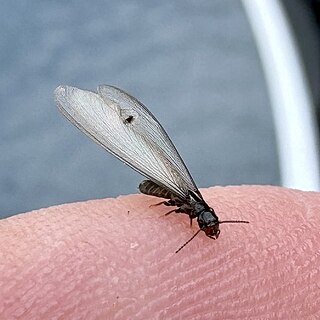
Reticulitermes hesperus, the western subterranean termite, is a species of termite in the family Rhinotermitidae. It is found in Central America and North America. R. hesperus is native to the coast between British Columbia and Southern California. Like other subterranean termites, they live underground, where they have elaborate eusocial societies composed of a queen, workers, and soldiers, as well as a rotating case of sexually reproductive adults and their larval and immature offspring. The reproductive adults are the only ones with functional wings. The reproductive adults will swarm on warm days in spring and fall, particularly after a rain event, looking for mating partners. These termites prefer moist living environments and prefer to consume wood that has already been partially decayed by saprotrophic fungus.
Neotermes castaneus, known generally as the southern damp-wood termite or Florida dampwood termite, is a species of termite in the family Kalotermitidae. It is found in the Caribbean Sea, Central America, North America, and South America.
Polycesta hageni is a species of metallic wood-boring beetle in the family Buprestidae. It is found in North America.
Marginitermes hubbardi, commonly known as the light western drywood termite, is a species of termite in the family Kalotermitidae. It is found in Central America and desert regions of southwestern North America.
Marginitermes is a genus of termites in the family Kalotermitidae. There are at least three described species in Marginitermes.
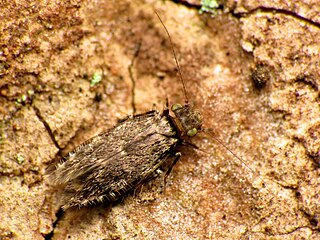
Echmepteryx hageni is a species of scaly-winged barklouse in the family Lepidopsocidae. It is found in North America.
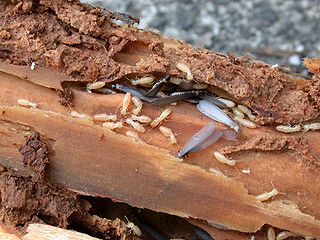
Reticulitermes speratus, the Japanese termite, is a species of subterranean termite found in Japan, North Korea, and South Korea. It eats decayed wood. It is adapted to withstand the cold temperatures of the temperate regions it inhabits.
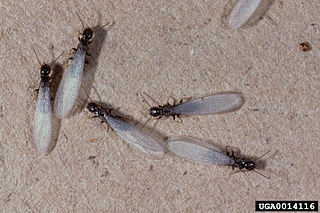
Reticulitermes virginicus is a species of subterranean termite native to North America, found often in the southern United States. It was described in 1907.

Reticulitermes tibialis, the arid-land subterranean termite, is a species of termite in the family Rhinotermitidae. It is found in the United States, mostly in the western half, occurring in deserts, prairies and other dry locations.











